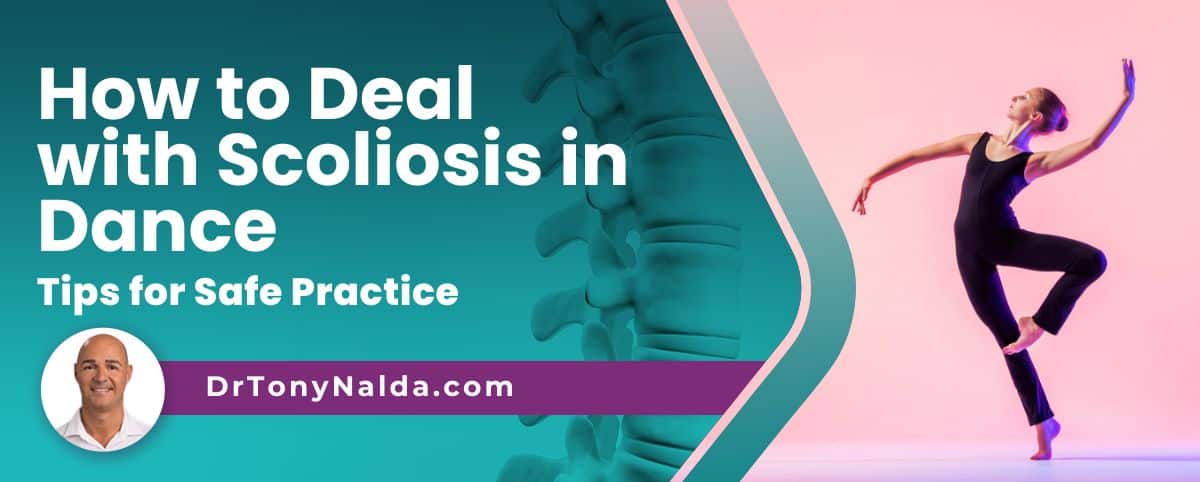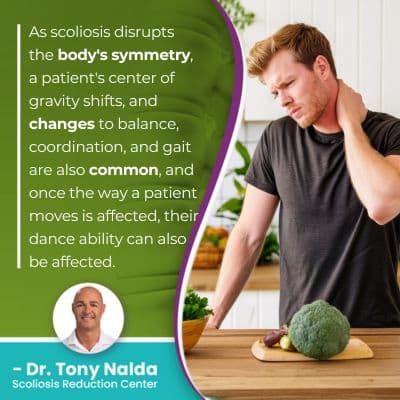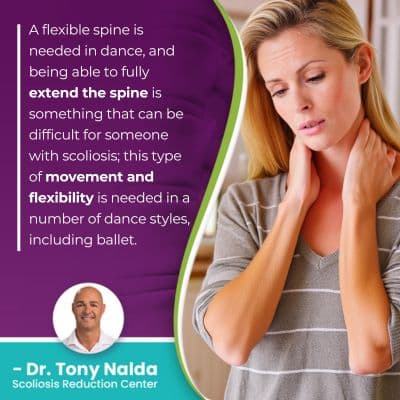How to Deal with Scoliosis in Dance: Tips for Safe Practice

Scoliosis introduces a lot of uneven forces to the body that disrupt its overall symmetry, and most types of dance are based on symmetrical movement. Scoliosis doesn't just cause the development of an unnatural sideways-bending and twisting spinal curve, it can also cause a muscular imbalance that can make performing symmetrical movements a challenge.
Activity restrictions can be a part of scoliosis treatment and life with the condition, but no two cases are the same; what one patient faces isn't a reliable indicator of what others will face. Condition severity and a patient's angle of trunk rotation are two important factors that can affect dance ability.
Activity restrictions are generally related to how the condition affects the body, so let's start with some of the most common effects of scoliosis.
Table of Contents
How Scoliosis Affects the Body
Scoliosis can affect the body differently based on a number of factors, two of which are a patient's Cobb angle measurement and angle of trunk rotation.
Scoliosis causes the development of an unnatural spinal curve to develop, and this disrupts the spine's alignment and biomechanics.
The higher a patient's Cobb angle, the more severe the condition, and the more noticeable its effects are likely to be.
In children, the most common effects involve postural changes caused by the condition's disruption of the body's overall symmetry; early signs often include uneven shoulders, shoulder blades, and hips, and additional changes can include the development of a rib cage arch, an uneven waist line, and arms and legs that appear to hang at different lengths.
 As scoliosis disrupts the body's symmetry, a patient's center of gravity shifts, and changes to balance, coordination, and gait are also common, and once the way a patient moves is affected, their dance ability can also be affected.
As scoliosis disrupts the body's symmetry, a patient's center of gravity shifts, and changes to balance, coordination, and gait are also common, and once the way a patient moves is affected, their dance ability can also be affected.
In adults, the most common effect of scoliosis is pain, and this is because scoliosis becomes a compressive condition once skeletal maturity has been reached, but in the context of dance, this is more relevant to adolescents, and adolescent idiopathic scoliosis is the most common type of scoliosis, so we'll focus on the topic of adolescents dancing with scoliosis.
Scoliosis is an asymmetrical condition, and most types of dance involve symmetrical movement, so let's talk about how those postural changes can affect a person's ability to dance.
Dancing with Scoliosis
It can be difficult to answer questions about safe activities for people with scoliosis because no two cases are the same, and what is deemed safe for some might not be deemed appropriate for others.
Two important factors are condition severity and the angle of trunk rotation.
Condition severity is determined by a measurement known as Cobb angle, and during X-ray, lines are drawn from the tops and bottoms of the curve's most-tilted vertebrae, and the resulting angle is expressed in degrees.
The higher a patient's Cobb angle, the larger the unnatural spinal curve is, the more severe the condition, the more noticeable its effects are likely to be, and the more likely it is that activity restrictions will be necessary.
Scoliosis doesn't just cause the spine to bend unnaturally to the side, but also twist, and the more rotation there is in the spine, the more postural changes there will be, and the more asymmetries there will be in the trunk that can affect a person's ability to hold themselves in a symmetrical position and move symmetrically.
So a patient with mild scoliosis is likely to have subtle postural and movement changes, whereas someone with moderate to severe scoliosis is going to have more noticeable disruptions to posture and movement.
There is also a difference between dance as a hobby and competitive dance; the more competitive a sport or activity is, the more time it will take, and the more strenuous it's likely to be for anyone, let alone someone with a progressive spinal condition.
Scoliosis causes postural changes that also affect movement, and when severe, changes to movement can also be overt.
Scoliosis Progression and Dance
The thing to remember is that even for those diagnosed with mild scoliosis, as a progressive condition, its nature is to get worse over time, so a diagnosis of mild scoliosis doesn't mean that's where it will stay.
So for young patients diagnosed with mild adolescent idiopathic scoliosis who don't notice changes to their ability to dance, this could change over time if progression is occurring.
Progression means the size of the unnatural spinal curve is increasing, as are the condition's uneven forces, and their effects.
A common effect of scoliosis progression is increasing spinal rigidity; not only does this make the spine less responsive to treatment, it disrupts spinal flexibility and range of motion.
A flexible spine is needed in dance, and being able to fully extend the spine is something that can be difficult for someone with scoliosis; this type of movement and flexibility is needed in a number of dance styles, including ballet.
In addition, scoliosis progression doesn't just affect the spine, but also its surrounding muscles, and a muscle imbalance is a common effect: another effect that can disrupt movement and dance.
Muscular Imbalance and Dance
As an unnatural spinal curve increases in size, it's pulling the spine's surrounding muscles in different directions, and this can cause the muscles on one side of the spine to become underused and weak, while muscles on the other side can become sore and stretched from overuse.
A muscle imbalance is part of the condition's asymmetrical effects, and being unable to perform equal movement on both sides of the body is a factor in dance.
As the spine is being pulled in an unnatural direction, it also takes more energy and strength to maintain an upright position and symmetrical movement, and while strength training can help, as scoliosis progresses, these issues become more pronounced; the best way to minimize the condition's effects is to treat it proactively.
Scoliosis Treatment and Dance
 A scoliosis diagnosis doesn't have to mean the end of a dancing career, but it can mean approaching the activity differently.
A scoliosis diagnosis doesn't have to mean the end of a dancing career, but it can mean approaching the activity differently.
While no type of dance or exercise should be attempted before it's cleared by a patient's scoliosis treatment provider, staying active and strong is important for people with scoliosis.
In fact, part of scoliosis treatment focuses on the use of physical therapy and scoliosis exercises to strengthen the core muscles so they can optimally support the spine, increasing spinal stability.
A curved spine can make it difficult to stand upright and practice good posture, and dance does encourage postural awareness, and while there are never treatment guarantees, with early detection and intervention, there are fewer limits to what nonsurgical treatment can achieve.
Conservative treatment is modern and proactive so is started as close to the time of diagnosis as possible, and it's important for scoliosis patients to understand that there are different ways to address scoliosis, and the different approaches will shape the spine's long-term spinal health differently.
Conservative treatment works towards preserving as much of the spine's natural strength, flexibility, and function as possible, so for dancers, this is the best approach for maintaining the spine's range of motion.
Conservative treatment combines the power of chiropractic care, physical therapy, corrective bracing, and rehabilitation so condition's are impacted on every level; this approach is aligned with the spine's movement-based design, but traditional spinal fusion surgery, however, is not.
Scoliosis Surgery and Dance
When it comes to traditional scoliosis treatment, the response is not proactive, it's reactive; rather than starting treatment immediately following a diagnosis when conditions are at their mildest and most treatable, watching and waiting is commonly recommended.
As a progressive condition triggered by growth, and considering the rapid and unpredictable growth spurts of puberty, this can be dangerous; young patients can progress significantly in the interim between assessments, but had treatment been applied earlier, progression may have been preventable.
Many cases of scoliosis don't require surgery, and for a dancer who's concerned with one side of their body being stronger than the other and postural changes, the best treatment option is one that's specifically tailored to address the patient's body and condition type; these patients are the most likely to be able to continue dancing recreationally.
Conclusion
The reality is that patients of a young age are highly resilient, particularly when their scoliosis is diagnosed early and treated proactively, but when it comes to competitive dance, it's likely to be affected.
Scoliosis can make it difficult to stand and move symmetrically, and a muscular imbalance that's also associated with scoliosis can disrupt a patient's ability to perform equal symmetrical movements on both sides of the body.
Any activity that places the spine in unnatural positions, requires hyperextending the spine, or overuses one side of the body can be unsafe for some people with scoliosis; dance can also have a number of benefits as a form of exercise to keep the spine lose and strong, along with its surrounding muscles and a strong core.
Dance recommendations/restrictions need to be determined by a patient's scoliosis treatment provider, and if appropriate for a patient's individual type and severity of scoliosis, the approach to dance can be shaped and with the right support, some scoliosis patients still find fulfillment in dance.
There are a number of famous athletes and celebrities that have gone to to fulfill their life's dreams, despite having scoliosis, and when it comes to the spine's long term health, proactive treatment that addresses the underlying structural nature of scoliosis, along with increasing core strength, is the best way to minimize the condition's effects.
Dr. Tony Nalda
DOCTOR OF CHIROPRACTIC
After receiving an undergraduate degree in psychology and his Doctorate of Chiropractic from Life University, Dr. Nalda settled in Celebration, Florida and proceeded to build one of Central Florida’s most successful chiropractic clinics.
His experience with patients suffering from scoliosis, and the confusion and frustration they faced, led him to seek a specialty in scoliosis care. In 2006 he completed his Intensive Care Certification from CLEAR Institute, a leading scoliosis educational and certification center.
About Dr. Tony Nalda
 Ready to explore scoliosis treatment? Contact Us Now
Ready to explore scoliosis treatment? Contact Us Now





